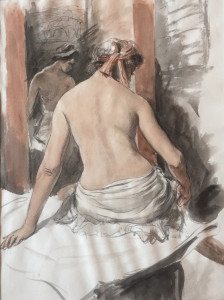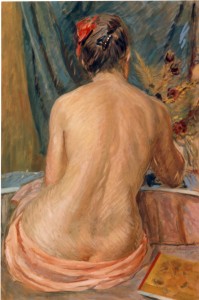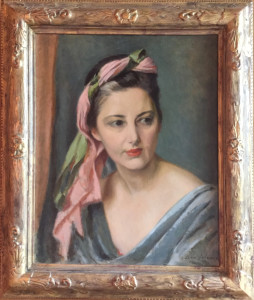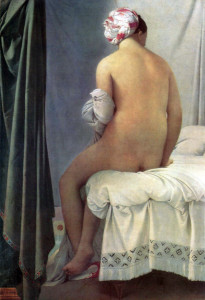To highlight works in the exhibition, Homage: Ben solowey’s Art iNspired by His Influences, we are providing articles on the artists he admired and the works they inspired:
Jean-Auguste-Dominique Ingres (1780 – 1867) was on a quest to capture the ideal beauty. A student of Jacques-Louis David, then Europe’s greatest artist, Ingres learned the Neoclassical style but soon emphasized the contours of his figures, in a way, becoming one of the first Modern painters. Though he was dedicated to the academic panting of the classical era in his early life, he would eventually become experimental in his art, breaking many of the boundaries set by the classical painters.
Like Ben, Ingres felt that drawing was the foundation of art, and his paintings and drawings reveal his detailed approach to draughtsmanship. Ben Solowey collected reproductions of both his drawings and of his most famous paintings, “La Grande Odalisque,†one of the first pure nudes (without any historical justification), which Ben alluded to in a number of works throughout his career, and “The Valpincon Bather.â€
“The Valpincon Bather†is one of Ingres’ most renowned works. The nude, seen from the back, has many anatomical distortions that would become synonymous with Ingres. This work is considered to be his first great work of the nude. One critic remarked “Rembrandt himself would have coveted the amber colour of this pale torso.” The painting would inspire a number of Solowey paintings and drawings, and like Ingres himself, he would return to the figure throughout his career. He kept a reproduction of the work in his studio and in his oil, “Still Life Materials,” now in the collection of the James A. Michener Art Museum, which depicts elements of still life paintings, he included the reproduction – a direct acknowledgement of the inspiration, virtually the only time he made such a direct link.
 In an undated work on paper, Ben brings a soft treatment of the body to his own version of the Valpincon Bather. Here, Rae models for this modern adaptation in his New York studio. The pose is not identical, but the view of the bather from the back along with the pink and white turban hints to the Ingres tradition Solowey is drawing upon. He combines it with a fascination with mirrors that can be traced to the work of Manet. With the addition of the mirror, we can see the front of the nude, though the reflection is dark and less defined. While much of the background has a sketch quality to it, the skin of the nude is soft and supple, not unlike the original Ingres’ work. Ben stayed true to reality with anatomically correct proportions.
In an undated work on paper, Ben brings a soft treatment of the body to his own version of the Valpincon Bather. Here, Rae models for this modern adaptation in his New York studio. The pose is not identical, but the view of the bather from the back along with the pink and white turban hints to the Ingres tradition Solowey is drawing upon. He combines it with a fascination with mirrors that can be traced to the work of Manet. With the addition of the mirror, we can see the front of the nude, though the reflection is dark and less defined. While much of the background has a sketch quality to it, the skin of the nude is soft and supple, not unlike the original Ingres’ work. Ben stayed true to reality with anatomically correct proportions.
 “Red Ribbon,†a 1956 casein, also pays tributes to Ingres’ classic work, this time painted in the distinct Solowey style with vibrant colors and Rae modeling once again.
“Red Ribbon,†a 1956 casein, also pays tributes to Ingres’ classic work, this time painted in the distinct Solowey style with vibrant colors and Rae modeling once again.
In a 1950 oil, “Pink Turban,†Ben turns his model around and gives us a portrait of Rae, as if to to reveal the identity of his bather. It was a work that must have been close to his heart and his made the canvas himself, and in our Homage exhibition, it is one of Ben’s best hand carved, gold  leaf frames.
leaf frames.
Katherine Eastman
Associate Curator











